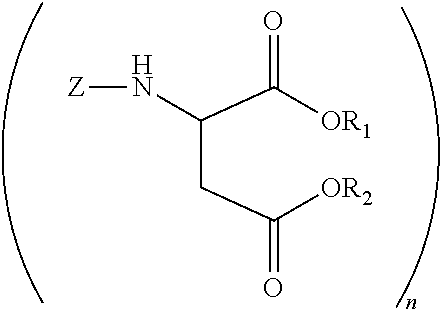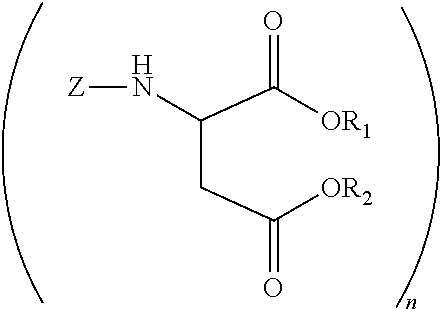Polyurea compositions from polyaspartic esters and secondary heterocyclic amines derived aspartic esters
a technology of aspartic esters and polyaspartic esters, which is applied in the direction of polyurea/polyurethane coatings, coatings, etc., can solve the problems of affecting the working life or pot life of these mixtures, and affecting the application of coatings. the effect of saving and being more environmentally friendly
- Summary
- Abstract
- Description
- Claims
- Application Information
AI Technical Summary
Benefits of technology
Problems solved by technology
Method used
Image
Examples
example 1
on of Polyaspartic Ester / Aspartic Ester Mixture from Diethyl Maleate, 4,4′-diaminodicyclohexylmethane (PACM) and Piperidine
[0044]A 2 L glass reactor equipped with a N2 inlet tube, thermocouple and addition funnel was charged with 4,4′-diaminodicyclohexylmethane (PACM) (470.72 g, 2.0 mole) and heated to 80° C. Diethyl maleate (688.8 g, 4 mole) was slowly added while maintaining the temperature at 80-85° C. The mixture was kept at this temperature for 6 h. An oliquot sample analyzed by gas chromatography indicated the presence of 5 wt % (0.32 mole) of diethyl fumarate. Piperidine (27.48 g, 0.32 mole) was added and the mixture was brought to ambient temperature. After 3 days there was no diethyl fumarate detected by gas chromatography.
example 2 preparation
of Polyaspartic Ester / Aspartic Ester Mixture from Diethyl Maleate, 4,4′-diaminodicyclohexylmethane (PACM) and Pyrrolidine
[0045]A 2 L glass reactor equipped with a N2 inlet tube, thermocouple and addition funnel was charged with 4,4′-diaminodicyclohexylmethane (PACM) (470.72 g, 2.0 mole) and heated to 80° C. Diethyl maleate (688.8 g, 4 mole) was slowly added while maintaining the temperature at 80-85° C. The mixture was kept at this temperature for 6 h. An oliquot sample analyzed by gas chromatography indicated the presence of 5 wt % (0.32 mole) of diethyl fumarate. Pyrrolidine (22.90 g, 0.32 mole) was added and the mixture was brought to ambient temperature. After 3 days there was no diethyl fumarate detected by gas chromatography.
example 3
on of Polyaspartic Ester / Aspartic Ester Mixture from Diethyl Maleate, 4,4′-diaminodicyclohexylmethane (PACM) and Piperazine
[0046]A 2 L glass reactor equipped with a N2 inlet tube, thermocouple and addition funnel was charged with 4,4′-diaminodicyclohexylmethane (PACM) (470.72 g, 2.0 mole) and heated to 80° C. Diethyl maleate (688.8 g, 4 mole) was slowly added while maintaining the temperature at 80-85° C. The mixture was kept at this temperature for 6 h. An oliquot sample analyzed by gas chromatography indicated the presence of 5 wt % (0.32 mole) of diethyl fumarate. Piperazine (27.69 g, 0.32 mole) was added and the mixture was brought to ambient temperature. After 7 days there was no diethyl fumarate detected by gas chromatography.
PUM
| Property | Measurement | Unit |
|---|---|---|
| Temperature | aaaaa | aaaaa |
| Temperature | aaaaa | aaaaa |
| Temperature | aaaaa | aaaaa |
Abstract
Description
Claims
Application Information
 Login to View More
Login to View More - R&D
- Intellectual Property
- Life Sciences
- Materials
- Tech Scout
- Unparalleled Data Quality
- Higher Quality Content
- 60% Fewer Hallucinations
Browse by: Latest US Patents, China's latest patents, Technical Efficacy Thesaurus, Application Domain, Technology Topic, Popular Technical Reports.
© 2025 PatSnap. All rights reserved.Legal|Privacy policy|Modern Slavery Act Transparency Statement|Sitemap|About US| Contact US: help@patsnap.com



